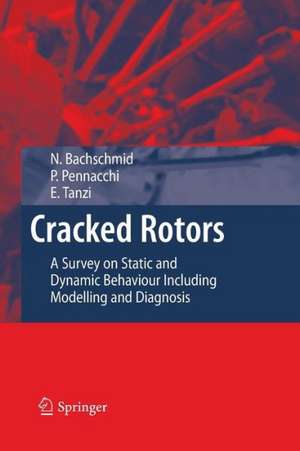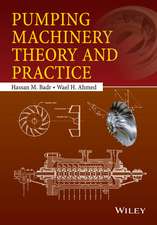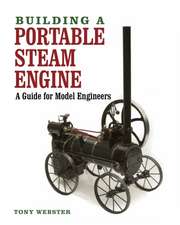Cracked Rotors: A Survey on Static and Dynamic Behaviour Including Modelling and Diagnosis
Autor Nicoló Bachschmid, Paolo Pennacchi, Ezio Tanzien Limba Engleză Paperback – 25 noi 2014
This monograph shows the typical dynamical behavior of cracked shafts and presents tests for detecting cracks. The book describes how to model cracks, how to simulate the dynamical behavior of cracked shaft, and compares the corresponding numerical with experimental results. All effects of cracks on the vibrations of rotating shafts are analyzed, and some results of a numerical sensitivity analysis of the vibrations to the presence and severity of the crack are shown. Finally the book describes some crack identification procedures and shows some results in model based crack identification in position and depth.
The book is useful for higher university courses in mechanical and energetic engineering, but also for skilled technical people employed in power generation industries.
| Toate formatele și edițiile | Preț | Express |
|---|---|---|
| Paperback (1) | 950.21 lei 6-8 săpt. | |
| Springer Berlin, Heidelberg – 25 noi 2014 | 950.21 lei 6-8 săpt. | |
| Hardback (1) | 956.33 lei 6-8 săpt. | |
| Springer Berlin, Heidelberg – 16 iul 2010 | 956.33 lei 6-8 săpt. |
Preț: 950.21 lei
Preț vechi: 1158.79 lei
-18% Nou
Puncte Express: 1425
Preț estimativ în valută:
181.83€ • 194.43$ • 151.60£
181.83€ • 194.43$ • 151.60£
Carte tipărită la comandă
Livrare economică 18 aprilie-02 mai
Preluare comenzi: 021 569.72.76
Specificații
ISBN-13: 9783642448751
ISBN-10: 3642448755
Pagini: 416
Ilustrații: XIV, 399 p.
Dimensiuni: 155 x 235 x 22 mm
Greutate: 0.58 kg
Ediția:2010
Editura: Springer Berlin, Heidelberg
Colecția Springer
Locul publicării:Berlin, Heidelberg, Germany
ISBN-10: 3642448755
Pagini: 416
Ilustrații: XIV, 399 p.
Dimensiuni: 155 x 235 x 22 mm
Greutate: 0.58 kg
Ediția:2010
Editura: Springer Berlin, Heidelberg
Colecția Springer
Locul publicării:Berlin, Heidelberg, Germany
Public țintă
Professional/practitionerDescriere
Cracks can develop in rotating shafts and can propagate to relevant depths without affecting consistently the normal operating conditions of the shaft. In order to avoid catastrophic failures, accurate vibration analyses have to be performed for crack detection. The identification of the crack location and depth is possible by means of a model based diagnostic approach, provided that the model of the crack and the model of the cracked shaft dynamical behavior are accurate and reliable.
This monograph shows the typical dynamical behavior of cracked shafts and presents tests for detecting cracks. The book describes how to model cracks, how to simulate the dynamical behavior of cracked shaft, and compares the corresponding numerical with experimental results. All effects of cracks on the vibrations of rotating shafts are analyzed, and some results of a numerical sensitivity analysis of the vibrations to the presence and severity of the crack are shown. Finally the book describes some crack identification procedures and shows some results in model based crack identification in position and depth.
The book is useful for higher university courses in mechanical and energetic engineering, but also for skilled technical people employed in power generation industries.
This monograph shows the typical dynamical behavior of cracked shafts and presents tests for detecting cracks. The book describes how to model cracks, how to simulate the dynamical behavior of cracked shaft, and compares the corresponding numerical with experimental results. All effects of cracks on the vibrations of rotating shafts are analyzed, and some results of a numerical sensitivity analysis of the vibrations to the presence and severity of the crack are shown. Finally the book describes some crack identification procedures and shows some results in model based crack identification in position and depth.
The book is useful for higher university courses in mechanical and energetic engineering, but also for skilled technical people employed in power generation industries.
Cuprins
Cracks in Rotating Shafts.- Typical Dynamic Behaviour of Cracked Shafts.- Rotor Testing for Crack Detection.- Laboratory Tests on Cracked Shafts.- Crack Modelling.- Results Obtained Using Simulations.- Some Special Effects Caused by Cracks.- Crack Diagnosis in Rotating Shafts.
Textul de pe ultima copertă
Cracks can develop in rotating shafts and can propagate to relevant depths without affecting consistently the normal operating conditions of the shaft. In order to avoid catastrophic failures, accurate vibration analyses have to be performed for crack detection. The identification of the crack location and depth is possible by means of a model based diagnostic approach, provided that the model of the crack and the model of the cracked shaft dynamical behavior are accurate and reliable.
This monograph shows the typical dynamical behavior of cracked shafts and presents tests for detecting cracks. The book describes how to model cracks, how to simulate the dynamical behavior of cracked shaft, and compares the corresponding numerical with experimental results. All effects of cracks on the vibrations of rotating shafts are analyzed, and some results of a numerical sensitivity analysis of the vibrations to the presence and severity of the crack are shown. Finally the book describes some crack identification procedures and shows some results in model based crack identification in position and depth.
The book is useful for higher university courses in mechanical and energetic engineering, but also for skilled technical people employed in power generation industries.
This monograph shows the typical dynamical behavior of cracked shafts and presents tests for detecting cracks. The book describes how to model cracks, how to simulate the dynamical behavior of cracked shaft, and compares the corresponding numerical with experimental results. All effects of cracks on the vibrations of rotating shafts are analyzed, and some results of a numerical sensitivity analysis of the vibrations to the presence and severity of the crack are shown. Finally the book describes some crack identification procedures and shows some results in model based crack identification in position and depth.
The book is useful for higher university courses in mechanical and energetic engineering, but also for skilled technical people employed in power generation industries.
Caracteristici
Cracks are described an analysed from the practical point of view in industry
Modeling facilitates the computational analysis of cracks
Many practical examples illustrate the basic concept
Modeling facilitates the computational analysis of cracks
Many practical examples illustrate the basic concept











